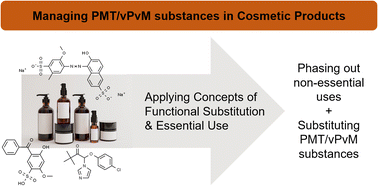Managing PMT/vPvM substances in consumer products through the concepts of essential-use and functional substitution: a case-study for cosmetics†
Abstract
Measures are needed to protect water sources from substances that are mobile, persistent and toxic (PMT) or very persistent and very mobile (vPvM). PMT/vPvM substances are used in a diverse range of applications, including consumer products. The combined application of the essential-use and functional substitution concepts has been proposed to phase out substances of concern and support the transition to safer and more sustainable chemicals, a key goal of the European Commission’s Chemicals Strategy for Sustainability. Here, we first identified the market share of PMT/vPvM containing cosmetic products. We found that 6.4% of cosmetic products available on the European market contain PMT or vPvM substances. PMT/vPvM substances were most often found in hair care products. Based on their high occurrence, the substances Allura red (CAS 25956-17-6), benzophenone-4 (CAS 4065-45-6) and climbazole (CAS 38083-17-9) were selected as case-studies for assessment of their functionality, availability of safer alternatives and essentiality. Following the functional substitution framework, we found that the technical function of Allura red was not necessary for the performance of some cosmetic products, making the use non-essential. For other applications of Allura red, as well as all applications of benzophenone-4 and climbazole, the technical function of the chemical was considered necessary for the performance. Via the alternative’s assessment procedure, which used experimental and in silico data and three different multicriteria decision analysis (MCDA) strategies, safer alternatives were identified for all case-study chemicals. All assessed uses of PMT/vPvM substances were thus deemed non-essential and should consequently be phased out.

- This article is part of the themed collection: Recent Open Access Articles


 Please wait while we load your content...
Please wait while we load your content...